THE PERFECT BIKEPACKING SETUP
- Tristan Ridley
- Apr 6, 2020
- 22 min read
Updated: Dec 15, 2020
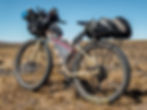
I am, unashamedly, a huge gear nerd. I’m also a bit of a perfectionist, and having been cycling around the world for more than three years now I’ve had ample time in the saddle, literally thousands of hours, to puzzle over optimising my bike and gear setup. I’ve changed things up several times over the years, inching closer to what I consider ‘the perfect setup’. Now, finally, I think I’ve got as close as I can to that perfection. There are one or two minor things I might tweak, but after three years of trial and error, the core of my system is now exactly where I want it. As far as I’m concerned I now have the ultimate all-round, round-the-world, hardcore expedition ready rig. This setup is fairly lightweight (base weight of bike + gear is around 28kg) but has a capacity of over 70 litres and allows me to easily carry food for more than two weeks while simultaneously carrying 13 litres of water. Versatility is huge and I can easily expand on my capacity if needed; if I had to I could stretch this to carry a month’s food without too much difficulty. Convenience is also fantastic and this setup is a pleasure to use.
LARA: Surly ECR, 29+

The biggest change I've made since starting my trip was switching from the 26" Surly Long Haul Trucker, which I used for my first year of touring, to the 29+ Surly ECR. I have now been touring on the ECR for almost two years, and I have to say that I'm very happy with it. The massive 29"x3.0" 'plus tyres' allow me to comfortably ride routes which would have been an absolute nightmare before, and I can now continue pedalling on trails which would unquestionably have been hike-a-bike on a bicycle with ordinary tyres. Grip and cushioning is excellent, and the geometry of the ECR is exceptionally comfortable. On paved roads the plus tyres still roll surprisingly well - I use Maxxis Chronicles, which I've also been very happy with, and with the tyres pumped up to high pressure (and with a lightweight bikepacking setup and aerobars) I am still actually FASTER on pavement using plus tyres than the majority of other 'normal' bike tourers with whom I've ridden. They really are great.
I have been running my tyres tubeless since the beginning, almost two years, and in my opinion tubeless is definitely the way to go for both bikepacking and touring. Although setup can seem daunting at first, once you know what you’re doing it’s actually extremely simple. Tubeless is absolutely brilliant; punctures are no concern for me whatsoever. In some desert sections with a lot of thorns, I’d say tubeless is more or less mandatory, and tubeless also allows you to use faster rolling, lighter tyres than would be reasonable if you were running tubes. Immunity to snakebite punctures is also great, as well as the ability to use very low tyre pressures when riding on soft surfaces. The wider your tyres, the more beneficial tubeless becomes, but even for skinnier tyres I think tubeless is too good not to use. I always carry at least one spare inner tube, so if anything does go wrong and my tubeless fails I can always easily switch back to using tubes, but in my experience tubeless has been fantastic and I’ve only had to do this a couple of times. I would really recommend making the switch to tubeless as it's well worth the effort over conventional tubes.
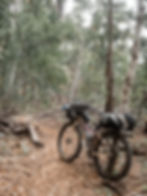
I'm massively sold on plus-tyres for bikepacking as I think they are pretty much the perfect compromise. For me, the only downside really is the difficulty finding replacement wheels/tyres, but with proper planning this is manageable, and in an emergency, you can always just use a regular 29er wheel, which would be much easier to find. I managed to make my 29+ setup work even in Africa, even despite a major wheel failure. If it's possible in Africa then it's possible anywhere. As for the comparison between 29+ and 27.5+, I can't really comment as I've never actually ridden a 27.5+. I went with 29+ for the extra rollover and the momentum-carrying properties of the larger wheels. I've been super happy with my choice and if I had to do it again I would probably still go with the 29+, but I'm sure I'd be perfectly happy with 27.5+ as well. 27.5+ has the advantage of being easier to find parts for since it's more internationally adopted, so there is an argument that 27.5+ is the better choice in that regard.

Drivetrain: I've been using 1x11 for two years now, currently with a 30t front chainring and an 11-46 cassette. I really like the simplicity of 1x and overall I've been pretty pleased with it. I haven't found range to be an issue, although I would ideally like to have an even lower granny gear. My current bottom gear gives me about 20 gear inches, which is decent but sometimes not quite as much as I'd like for the steepest climbs. When I get the chance, I will probably look at switching to a 2x11 setup in order to give myself an uber-low granny gear; with a 22t front chainring and a 46t cassette I'd have an insanely low 15 gear inch granny gear (for a great gear inch calculator see HERE). Would I recommend 1x11 for bikepacking? I've been mostly happy with it so I'd have to say yes, especially if you're riding light and aren't going anywhere with insanely steep hills. For round the world touring though I think that a 2x10 or 2x11 is probably the better option, mainly because a 1x doesn't give you a gear quite low enough for the toughest hills. I've mostly been pretty content with 1x11; it's nice not having to worry about a front derailleur and I really appreciate the simplicity. It's also much easier to keep clean and gives me extra clearance at the centre of the bike, so there are certainly some advantages to a 1x11. Ultimately either will work, but I'd lean towards a 2x10 or 2x11 in future.

Saddles: I am definitely a fan of leather saddles for long distance bikepacking. The Brooks Imperial I'm using now is perfect; super comfortable and I don't have any need whatsoever for padded shorts. I used a Brooks B17 for the first couple of years; it was really nice when cycling in an upright riding position but when I added aerobars, and increasingly found myself preferring a slightly more aggressive riding position, I started getting some unpleasant numbness in my 'gentleman's area'. The cutout of the Imperial completely stops this, while still being just as comfortable as the B17. Before trying the Imperial I also used a Brooks Cambium C15 Carved for around four months. I think it would be a decent road saddle as it was most comfortable in aero position, but overall I didn't really get on with it and I found padded shorts were necessary, which I didn't like. Certainly, it was a lot less comfortable than the Imperial. Leather saddles can sometimes take a while to break in (although I've generally found them to be reasonably comfortable even out of the box) but for touring I'd never want anything else. They might not be for everyone (saddles being a notoriously personal choice) but leather saddles are definitely right for me.
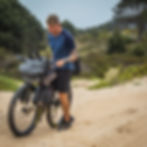
Brakes, Avid BB7: Hmm. So, they do work well, and I've never had a real problem with them. They've never let me down and they provide a good amount of stopping power so I suppose I'm happy with them. The main problem with the BB7s is that they can be a real pain in the arse to adjust, something which you do need to do once in a while. They can be very finicky. If I had to buy again I think I'd at least have a look around first and try to find something better. I don't want hydraulic disc brakes as I just don't quite trust them on such a long trip, especially as I spend so much time in very remote areas and do a lot of rough hike-a-bikes and the occasional hitchhike. I like the simplicity of mechanical disc brakes as I know I can easily fix any problems myself, and I know enough people that have had problems with hydraulic brakes on long trips to put me off using them. Overall, the BB7s have been fine for me.

Handlebars, Ritchey Comp Kyote: I did my first year on drop bars, and for anything other than pure road cycling I would never go back. Apart from being too narrow for control on technical routes, I found the forward drop position horrible for long descents on rough roads where you have to be hard on the brakes for long periods. I just found it to be much too far forward, which put too much pressure on my wrists - sometimes it made things really uncomfortable. I've since used various bars before settling on the Ritchey Comp Kyote which I now favour. I used the Jones Loop H bar for almost a year and although overall I think it's a great bar, the 45° sweep was just more than I wanted. I also tried a more regular riser bar (8° sweep) for a while but quickly realised that I definitely prefer something more swept back for touring. I find the 27.5° sweep of the Kyote to be around the sweet spot; it's very comfortable. I cut my bars down from the stock 800mm to around 740mm wide, which gives me excellent control even when heavily loaded. I previously used the ESI extra chunky grips, which I liked, but I definitely prefer the Ergon GC1 grips which I'm using now. Super comfortable! Like saddles, handlebars are subjective, but this setup certainly works perfectly for me.


Aerobars, Profile Designs Sonic Ergo 35a: I absolutely love these bars. Very few people tour or bikepack with aerobars and I've never heard of anyone else using aerobars on a fatbike so I guess it's worth writing something about why I like them so much. For me, it's not really about speed (though they do definitely make me faster) and more about comfort. I have mine setup in a relatively high aero position - not a full tuck like you'd see on a time trial bike but rather an 'endurance' position which I find very comfortable to sit in all day long. It rests my hands and reduces air resistance, making pedalling easier. Because I have my bars widely spaced I also have decent control in aero position even on rougher dirt roads. I absolutely love bikepacking with aerobars as they make the inevitable 'boring' sections go by much more comfortably. The Sonic Ergo 35a is absolutely perfect as far as I'm concerned, I wouldn't change a thing. Note: the small 'cross bar' between the aerobars on which I mount my smartphone using a Quadlock mount (which, incidentally, is absolutely brilliant - Quadlock is really a game changer) is very low tech - it's nothing more than a piece of wooden stick (which I found in Kenya) which I cut down and lashed on using string and duct tape. It's been a year since I put it on, and it hasn't budged an inch. Sometimes the simple solutions are the best.
BIKEPACKING BAGS

I would definitely never go back to panniers, and I absolutely love my hybrid bikepacking setup. Why no panniers? I actually used panniers for my first year of touring, but they just aren’t suitable for the kind of riding I do nowadays. I’ve ridden plenty of narrow singletrack routes where the extra width of panniers would have been an absolute nightmare. Panniers are heavier, less aerodynamic and have a far greater effect on bike handling. They are also prone to rattling around on rough ground, which can be annoying. My current setup has a capacity of more than 70 litres; pretty comparable to a standard 4-pannier touring setup, while being substantially lighter, better balanced, more effective offroad and quite a bit more versatile.

For shorter trips, bikepacking style seatpacks are great (I used the excellent Revelate Designs Terrapin for around 6 months), but for the kind of riding I do I much prefer the 'backpack on rear rack' system. The weight difference is not huge (around 500g for a seat pack vs. around 1500g for my setup; 500g for the rack, 900g for the backpack and 100g for the straps), but for the extra 1kg you get at least an extra 20 litres of capacity as well as a huge amount of extra versatility. When you need to carry extra food or water you can easily strap extra things onto the rack, and a backpack is also far quicker and easier to pack than a seat pack which needs to be packed tightly in order to be stable.
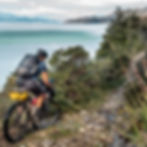
In my case, even if I were using a seatpack I would still want to bring along a backpack anyway, as I like to do side-hikes when off the bike, and a hiking backpack is simply such a useful thing to have that I'd never want to travel without one. As a result, the weight difference is completely cancelled out for me. Having a backpack on the rack is super convenient as I can easily take it off and wear it during hike-a-bike sections. For the REALLY tough hike-a-bikes I can move almost all of the heavy stuff into the pack and onto my shoulders, making hike-a-bikes vastly more comfortable.

Inside the backpack I normally pack only the things which I won't need during the day (tent, sleep system, toiletries and extra clothes) since once it’s strapped down it’s not as fast as other bags to access. I store my raincoat, gloves and waterproof jacket in zippered external pockets which I can get to easily without removing the backpack. I find this setup super convenient, as well as very fast to pack, attach or remove from the bike. It also sits extremely firmly on the rack with no movement whatsoever (strapped down using ROK motorcycle straps), so this setup is incredibly stable. The rack I’m using is the Tubus Vega Classic 29", which has been flawless. It weighs only 513 grams but is rated to carry up to 25kg. I’d say this rack is just about perfect. I had to modify it slightly to fit 29+ (slightly bending it by hand to increase tyre clearance) but my modification has been without issue. I’ve never so much as broken a bolt.
I'm currently using the Osprey Talon 33 backpack, which I'm very happy with, but I don't think it matters all that much which one you use as long as it's comfortable, not too heavy, and has a capacity of around 30 litres. Something with a good hip belt is definitely nice if you have to load it up with a lot of weight. If I want to side hike, the 33L backpack I have is plenty large enough for me to carry everything I need plus food for at least one week. Strapping extra things to the sides would extend this even further.
FRAMEBAG

I love framebags; they're such a great use of space and they keep the weight fantastically well centred. I keep my heaviest, densest things here, things like spaghetti or tinned food, and it's also where I keep a grab bag (containing my notebooks, Kindle and passport) for quick access during the day. It's also a good place to store bruisable fruit like bananas.
I used an Alpkit Stingray framebag for two years, and was super happy with it - Alpkit make fantastic gear and are highly recommended. Now though, I've upgraded to a fully waterproof custom roll-top framebag from Halawa (see photo above); the Stingray was still working perfectly but with my current setup I really wanted something waterproof. In my opinion, roll-tops are usually better than zippers for all but the smallest framebags as they let you cram in quite a bit more stuff while at the same time being more durable. Zippers will always fail eventually, especially when stressed by overstuffing and the dirt which will inevitably get into the zip, though to be fair, the original zip on my Stingray did remarkably well; making it the whole way through Africa before needing to be replaced. Zippered frame bags are still great and depending on the setup may be sometimes be a better option if you want quicker access, but personally I'd definitely recommend going for a roll-top if you have the choice.
FRONT HANDLEBAR BAG: JUMBO JAMMER
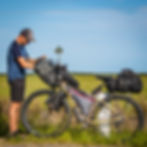
I really love this bag and I wish I'd had it years ago. From Roadrunner Bags, the 'Jumbo Jammer' has almost 30 litres of capacity (it's listed as 26 litres but I'm absolutely sure it can fit more than this when really loaded up) for only 900 grams of weight. It's rackless, but sits extremely securely on the handlebars even when very heavily loaded. Best of all it's a top-entry rolltop, which means it's super fast to access and very easy to pack. I previously used the much more common handlebar roll system (Revelate Designs Harness + Saltyroll) and although it works very well, the drybag is quite narrow so it's awkward to pack, and much less convenient to access once attached to the bike. It's also not really suitable for carrying solid objects like food as it needs to be packed fairly tightly to be secure, being much better suited to soft stuffable things like sleeping bags or clothes. The Jumbo Jammer on the other hand can easily be used to carry virtually anything that fits inside and is secure no matter how full or empty it is. Because the bag also has extra straps, it's also easy to attach extra things on top such as extra clothes, food, or in my case, my foam sleeping pad. The construction is really bombproof and so the bag's durability is fantastic - after 6 months of abuse mine is still completely good as new, and I expect it to last many more years of heavy duty bikepacking. I can't say enough good things about this bag!
WATER CAPACITY, AND WHY NO FORK CAGES + BAGS?
I recently got rid of my fork cages, mainly just for weight savings but also for the sake of simplicity. The weight of 2x Salsa Anything Cage HDs (which were flawless over the two years during which I used them) and two Salsa Anything Bags (plus straps) is almost 700 grams, but only gives you around 9 litres of capacity. That's a pretty bad weight-to-capacity ratio, compared to say the Jumbo Jammer which gives almost 30L for 900g. I could put water bottle cages on the forks instead, but I already have 3 litres of water capacity on the bike (2x 1L bottles in feederbags on the handlebars and 1x 1L bottle on the downtube) which is more than enough most of the time. I also have a 10L water bag which I can quickly and easily strap onto my rear rack whenever I need to carry more. I prefer to keep my main two water bottles in the feederbags rather than on the forks because they are super convenient to access there, and they also stay much cleaner than they would on the forks.
Lots of bikepackers use a seat pack with two fork bags (as I did for 6 months), but counter to fashionable bikepacking norms I actually think this is not the most optimal way to go. Many people on longer tours find that just a seatpack, handlebar roll and frame bag isn't quite enough capacity, which is why so many use fork bags and even find ways to strap on extra bottle cages to other parts of the bike. But personally I think switching to a rack instead of doing this makes much more sense. Switching to a rear rack + backpack from using a seatpack would give you around 20 litres of extra capacity (plus all the extra versatility of a rack + backpack) for an extra 1000g, As opposed to paying 700 grams of weight for only around 9 litres of capacity using fork bags. For me, it's a no-brainer to ditch the seatpack and fork bags in favour of just using a rack+backpack. It's also quite a lot cheaper, and the versatility factor is huge. For a mere extra 300 grams or so you get so much more potential. And yes, you could use larger dry bags on the forks than 4L. But then you end up with heavier and bulkier bags on the forks, which is a little too close to panniers for my liking.
MY SETUP VS THE CLASSIC BIKEPACKING SETUP

As a contrast between my hybrid setup and a more classic bikepacking setup, let’s look at weights and capacity comparisons, omitting the frame bag for now as it will be the same for both. Using my previous bikepacking setup as an example, I was using a Revelate Designs Harness and Saltyroll drybag (13L) on the front, with an Egress pocket on top (3L). On the back, I was using a Revelate Terrapin seatpack (14L). Capacity for this setup is 30 litres, with a total weight of around 1400g. Add in the two fork bags and the total weight for this very standard (and very effective) setup comes to around 2100g, with a total capacity of 39 litres. My current setup on the other hand has a total capacity of around 60 litres for a weight of 2400g. 300 grams of extra weight gets me 21 litres of capacity, a hiking backpack, much easier/faster packing, and much more versatility. Because I can easily strap a big 10L water bag onto my rack, water is also never an issue whereas with the classic bikepacking setup it’s often necessary to attach extra bottle cages to the bike using hose clamps. Doing this slants the weight comparison even further in favour of my setup – hose clamps are actually fairly heavy so when you start attaching extra bottle cages the weight quickly adds up and my setup ends up actually being lighter while still providing greater capacity. In my opinion, seat packs are only worth bringing if you don’t need the extra capacity of fork bags, which is likely to be only for shorter trips or rides where you’re never going too far from civilisation and so food capacity isn’t a factor. Obviously some bikes can't fit racks, but for those that can I think a rack will almost always be the better choice. If you don't want to bring a backpack you can always bring along a drybag instead, which will be even lighter.
CAMPING

Tarptent Moment DW: I used this for 1.5 years, it's a fantastic tent. Lightweight, tough and super fast to setup (I could pitch it in literally 1 minute flat) it was also good at shrugging off bad weather, keeping me comfortable through a few really nasty storms. Tarptent is a great company; I really like their tents and they also have excellent customer service so I can definitely vouch for them. I was very happy with this tent and overall I would definitely recommend it, although it is fairly small inside so for a really long tour I'd maybe go for something with a bit more internal space, something like the Rainbow or Bowfin 1S, both from Tarptent, might be more comfortable for most people.
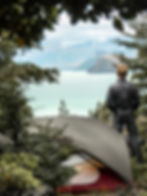
MSR Hubba Hubba Shield (2019): I was incredibly disappointed with this tent. The Hubba Hubba is a very popular tent and MSR have a good reputation, which I why I bought this in the first place. But the cross pole snapped after only four months. This despite the 2019 poles being made from MSR's new and supposedly much stronger 'Syclone' material. To be fair to MSR, their customer service was pretty good and they did agree to send me a replacement pole, but I just don't trust the tent after this. I hadn't even put it through what I'd consider to be any really extreme weather. Aside from its fragility, I have to admit that I wasn't particularly happy with the tent in general either. Although it's unquestionably a super comfortable tent, especially for just one person (it's a two person tent), I just found it took way too long to put up. Admittedly I'm pretty spoiled by the 1.5 years I spent with the Moment DW which went up in only one minute, but to me spending around 8 minutes every day putting up the MSR just felt like forever. I also found the Hubba Hubba to be a bit too bulky for storage, though in fairness it's a two person tent so if you were splitting it with a partner it would be fine. Ultimately though I just wasn't happy with it and when the pole snapped I decided to send it home. I might use it again one day if I'm travelling with a friend in what I expect to be only good weather, but overall this is one of the few things I've ever bought that I really regret buying. WOULD NOT RECOMMEND.

Tarptent Rainbow: After sending back the MSR, I arranged to bring in another Tarptent as after so long in the Moment I definitely trust these tents. I'm pleased to be sleeping in a Tarptent again and so far the Rainbow has been a pleasure to use. It's too soon for me to say much about it as I've only had it for a month or so, but early impressions are very good. It's fast to pitch (around 2 minutes), packs down very small, and the internal space is absolutely perfect for one person. You could sleep two inside, though it would be tight, but for one person it's enough space to be comfortable without being too palatial. It actually has a really small footprint which is great for squeezing into tight spaces. It's a single wall tent (whereas the others have all been double wall) so site selection is more important for managing condensation, but that's not something that worries me. I'll update this once I've had it for longer but so far I'm very happy with the Rainbow.
SLEEPING PADS
Over the years I've used two different inflatable air mattresses; the Thermarest NeoAir XLite and the Sea to Summit Ultralight Insulated. Both were warm, comfortable, light and compact; great mats, very high quality. That said, I have now completely given up on air mattresses, at least for the very long term expedition I am currently on. It's been my experience that sooner or later, all air mats will inevitably fail. I've gone through two Thermarests and two Seat to Summits - they were all covered under warranty and have been replaced, but I'm simply fed up of having to deal with it every few months. I've actually never had to fix a puncture on any of the mats as I'm very careful with site selection, but I've suffered instead mostly from delamination issues. I've always been careful to keep the mats clean, but sooner or later they've always still failed.
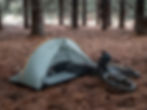
These days I'm just using a basic closed cell foam (CCF) pad. I previously used the Thermarest ZLite SOL for around 1.5 years and am now using a cheapo Naturehike replica, which is more or less the same thing. CCF pads aren't as warm or comfortable as air mats, but you get used to them and I still find it reasonably comfortable. CCF pads are very lightweight and essentially unbreakable, and I really like their simplicity. They're bulky, but I cut mine down to torso size which helps - I don't find I need any padding under my legs and I can always just use my backpack for insulation from the ground if it's cold. The foam pad is also much more versatile than an air mat and I often use it just to sit on during lunch breaks, or for yoga and stretching. It's bulk doesn't bother me as I simply strap it onto the outside of my Jumbo Jammer, which also makes it quick to access. I don't think I'd go back to using an air mat now except maybe for very short trips of up to a month or so; for anything longer I'd always reach for the CCF pad.
SLEEPING BAGS

Enlightened Equipment Revelation 20F/-7C: Overall this down quilt is a good piece of kit. It's very light, packs small and has generally been warm enough to keep me comfortable most of the time. That said, mine is supposed to be rated to 20F/-7C and I've found it to be nowhere near warm enough for that. Not even close. The distribution of the down isn’t great; with not enough in the centre and too much on the sides. It’s possible that I just got a botched one, but either way it was like this even from new. I also don’t really think that I’m sold on quilts personally; I find them a bit too draughty for my liking. If I were buying again I definitely think I would stick to a more conventional sleeping bag.
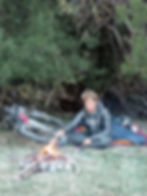
Z-Packs sleeping bag 40F/4C: I’ve had this for years, so I don’t think they’re even making this model any more. Really good sleeping bag, super lightweight, packable and I’d say the temperature rating is about right. My only criticism is that after several years of use mine has lost a LOT of feathers, maybe because the material is so thin, and so it’s definitely no longer as warm as it used to be. To be fair though, in the early days I was definitely over-compressing it which won’t have done it any good. I would happily buy this sleeping bag again, although I’d go for the 20F/-7C one next time.
I’m currently carrying both of these sleeping bags in order to be ready for the more extreme temperatures of potentially down to -20C/-4F which I’m expecting higher up in the Andes over the winter. Carrying two sleeping bags is definitely not ideal as it’s heavier than carrying just one really good bag, but neither of the ones I currently have are warm enough alone and I can’t afford to buy a new one right now. Doubling up the sleeping bags works pretty well and combined with all my clothes and maybe even an emergency blanket I’m confident I’ll be able to sleep even when it gets really cold.
COOKING SYSTEM
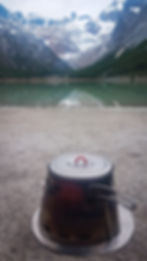
I've already written an in-depth review of my cook system, the Trail Designs Sidewinder Ti-Tri, which you can find HERE. Suffice to say that I absolutely love it, massively recommend it and wouldn't consider using anything else. After a year of using a multifuel stove (the MSR Whisperlite) I'm very happy to have switched to cooking with alcohol. I also use a homemade pot cosy, which works phenomenally well. For me, my cook system is absolutely perfect. One other thing which I carry and find very useful is a small (700ml) screw-top Tupperware container. It's cheap and lightweight (I found it in a random supermarket) but lets me carry leftovers in a sealed container and is also convenient for my morning oatmeal (which I eat uncooked) and for cold-soaking things like cous-cous or instant mashed potato. I also use the lid as a small chopping board, it's a handy thing to carry.
ELECTRONICS
I keep my devices charged using a combination of a 20,000mAh battery pack (Anker PowerCore – still going strong after almost two years and highly recommended) and a portable solar charger (Anker PowerPort Solar – I’ve only had this for five months but so far so good, no complaints and it works really well).

I think that for most people, a 20,000mAh battery pack is all you really need as it usually lasts at least a week or so and most people are going to stop somewhere at least once a week where they can recharge it overnight. I carry the solar panel because I like to be completely self-sufficient with power; I don’t want to HAVE to stop in civilisation unless I really want to. The solar panel ensures my independence and also means that I can ride even longer and more remote routes without having to worry about power. I could use a dynamo hub instead, but these are much more expensive if you want a good one, and it also adds more unnecessary complexity to the wheel. With all the rough hike-a-bike and river crossings I do I’m doubtful that even the best dynamo hub would survive long anyway.

Most of the time I just use my solar panel off the bike, quickly setting it up in mornings, evenings and during lunch breaks. I’m not generally wanting for power so I find this is plenty to keep me charged. If I’m really in need of extra juice I can easily strap the solar panel onto my rear rack or onto my front bag (depending on where the sun is) so power is never really a concern unless I ever had weeks on end of rain and clouds, but in those cases I’d probably want to find some shelter anyway.


Camera: I’m really not much of a photographer, and until 6 months ago I was still making do with just my very average smartphone camera. I’m now using the first and only camera I’ve ever owned, the Panasonic Lumix DMC-TZ70. It’s far from a great camera, just a relatively cheap compact (point and shoot), but it’s still a definite step up from my basic smartphone and takes decent photos. Just having access to an optical zoom has made a huge difference for composition. Though part of me would love a nice DSLR or mirrorless camera, I do actually think that, for me at least, a compact camera is ideal for bikepacking. Simple, not too expensive, and both lightweight and small enough that I can have it carabiner-clipped to my belt (in a hard protective case) for super-fast access on the move. If I had the money I’d love to upgrade to something like the Panasonic Lumix ZS100, which has a much better 1” sensor (the sensor on the TZ70 is tiny), but for now it’s out of my budget. One day!

Smartphone, Samsung Galaxy S7: Great phone - still alive after two years of abuse, albeit showing definite signs of wear. I don’t carry a laptop, so my smartphone is used for pretty much everything including route planning, navigating, music, web browsing and photo/video editing. I much prefer Android to Apple and I’ve been very happy with the Samsung. When possible I do want to get a new one as my current phone is starting to have a few problems, and I’ll probably go for another Samsung, maybe the next model up. For now though my current phone gets the job done!
For my full gear list see HERE, and feel free to get in touch if you have any questions!







